V8 engine
A V8 engine is an eight-cylinder piston engine in which the cylinders share a common crankshaft and are arranged in a V configuration.[1]
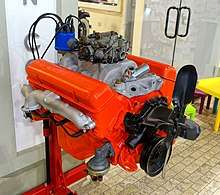
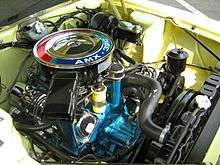
The first known working V8 engine was produced by the French company Antoinette in 1904 for use in aircraft, and the 1914–1935 Cadillac L-Head engine is considered the first automotive V8 engine to be produced in significant quantities. The popularity of V8 engines in cars was greatly increased following the 1932 introduction of the Ford Flathead V8.
Design
V-angle
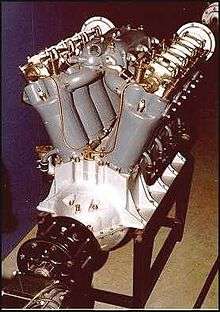
The majority of V8 engines use a V-angle (the angle between the two banks of cylinders) of 90 degrees. This angle results in good engine balance, which results in low vibrations; however, the downside is a larger width than V8 engines that use a smaller V-angle.
V8 engines with a 60 degree V-angle were used in the 1996–1999 Ford Taurus SHO, the 2005–2011 Volvo XC90, and the 2006–2009 Volvo S80. The Ford engine used a 60 degree V-angle because it was based on a V6 engine with a 60 degree V-angle. Both the Ford and Volvo engines were used in transverse engine chassis, which were designed for a front-wheel drive layout (with on-demand all-wheel drive system in the case of the Volvos). To reduce the vibrations caused by the unbalanced 60 degree V-angle, the Volvo engines used a balance shaft and offset split crankpins.[2] The Rolls-Royce Meteorite tank engine also used a 60 degree V-angle, since it was derived from the 60 degree Rolls-Royce Merlin V12 engine.[3]
Other V-angles have been used occasionally. The Lancia Trikappa, Lancia Dilambda, and Lancia Astura, produced 1922–1939, used narrow angle V8 engines (based on the Lancia V4 engine) with V-angles of 14—24 degrees.[4] The 1932 Miller four-wheel drive racing cars used a V8 engine with a V-angle of 45 degrees.[5] The 8-cylinder versions of the 1945–1966 EMD 567 diesel locomotive engine also used a V-angle of 45 degrees.
Crankshaft configuration
Cross-plane crankshaft
Most V8 engines fitted to road cars use a cross-plane crankshaft, since this configuration has less vibrations due to the perfect primary balance and secondary balance.[6] The cross-plane crankshaft has the four crank pins (numbered from the front) at angles of 0, 90, 180, and 270 degrees, which results in a cross shape for the crankshaft when it is viewed from one end.
The iconic rumbling exhaust sound produced by a typical cross-plane V8 engine is partly due to the uneven firing order within each of the two banks of four cylinders. A typical firing order of L-R-L-L-R-L-R-R (or R-L-R-R-L-R-L-L) results in uneven intake and exhaust pulse spacing for each bank. When separate exhaust systems are used for each bank of cylinders, this uneven pulsing results in the rumbling sound that is typically associated with V8 engines. However, racing engines seek to avoid these uneven exhaust pressure pulses, in order to maximise the power output. In order to link the exhaust systems from each bank (to provide even exhaust gas pulses), 1960s cross-plane V8 racing engines have either used long primary exhaust pipes (such as the Ford GT40 endurance racing car) or located the exhaust ports on the inside of the V-angle (such as the Lotus 38 IndyCar).
Flat-plane crankshaft
On the other hand, a flat-plane crankshaft is used by many V8 engines fitted to racing cars.[7]
This configuration provides two benefits. Mechanically, the crankshaft can be machined from a flat billet, and does not require counterweights so it is lighter. However it produces more vibration due to a secondary imbalance.
From the gas dynamics aspect, the flat-plane crankshaft allows for even exhaust gas pulsing to be achieved with a simple exhaust system.[8] The design was popularized in motor racing by the 1961–1965 Coventry Climax FWMV Formula One engine, and the 1967–1985 Cosworth DFV engine was highly successful in Formula One.[9] Several production sports cars have used flat-plane V8 engines, such as every Ferrari V8 model (from the 1973 Ferrari 308 GT4 to the 2019-present Ferrari F8 Tributo), the Lotus Esprit V8, the Porsche 918 Spyder, and the McLaren MP4-12C.
Most early V8 road car engines also used a flat-plane crankshaft, since this was simpler to design and build than a cross-plane crankshaft. Early flat-plane V8 engines included the 1910 De Dion-Bouton engine, the 1915 Peerless engine, and the 1915 Cadillac engine.
Origins
The first known V8 engine was the Antoinette engine, designed by Léon Levavasseur, which was first built in 1904.[10] The Antoinette was built in France for use in speedboat racing and airplanes.[11] A 1905 version of the Antoinette engine produced 50 hp (37 kW) with 86 kg (190 lb) of weight (including cooling water), resulting in a power-to-weight ratio that was not surpassed for 25 years.[12] Also in 1904, V8 engines began small-scale production by Renault and Buchet for use in airplanes and racing cars.
In 1905, the first V8 engine used in a road-going car was the Rolls-Royce V-8 built in the United Kingdom. This model was initially produced with a 3.5 L (214 cu in) V8 engine, however only three cars were produced before Rolls-Royce reverted to using straight-six engines.[13][11] In 1907, the Hewitt Touring Car became the first car built in the United States with a V8 engine.[14] The 1910 De Dion-Bouton— built in France— is considered to be the first V8 engine produced in significant quantities.[15][16]
The 1914 Cadillac L-head V8 engine is considered to be the first mass-production V8 engine.[11][17] This engine was built in the United States and was greatly assisted by Cadillac's pioneering use of electric starter motors.
Early airplanes continued to use V8 engines, such as the 1915 Hispano-Suiza 8 SOHC engine designed in Switzerland. This engine was used by American, French, and British military aircraft in World War One. It is estimated that approximately half of all Allied aircraft were powered by the Hispano-Suiza 8 engine.
.jpg) Vulcan automobile engine (circa 1919)
Vulcan automobile engine (circa 1919)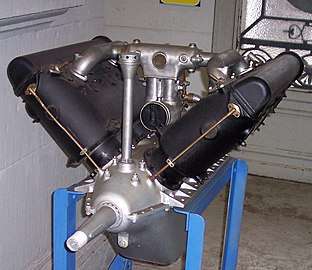 1914–1918 Hispano-Suiza 8A airplane engine
1914–1918 Hispano-Suiza 8A airplane engine
Usage in automobiles
The V8 engine with a cross-plane crankshaft is a common configuration for large automobile engines. The displacement of modern V8 engines is typically between 3.5 to 6.0 L (214 to 366 cu in), though larger and smaller examples have been produced, such as the 8.2 L (500 cu in) V8 engine used in the 1971–1978 Cadillac Eldorado.
Due to its large external dimensions, V8 engines are typically used in cars that use a longitudinal engine layout and rear-wheel drive (or all-wheel drive). However, V8 engines have also occasionally been used in transverse engine front-wheel drive vehicles, sometimes using closer cylinder bore spacings and narrower cylinder bank angles to reduce their space requirements.[18]
Australia
_03.jpg)
.jpg)
The first Australian designed car to use a V8 engine was the 1965 Chrysler Valiant (AP6), which was available with an American-built 4.5 L (273 cu in) Chrysler engine. The first locally designed V8 Ford was the 1966 Ford Falcon (XR) and the first V8 Holden was the 1968 Holden HK, both using engines supplied by their parent companies in the United States.
The first V8 engine to be mass produced in Australia was the 1969–2000 Holden V8 engine. This cast-iron overhead valve engine used a V-angle of 90 degrees and was built in displacements of 4.1 L (253 cu in) and 5.0 L (308 cu in), the latter being de-stroked to 5.0 L (304 cu in) in 1985. The Holden V8 engine was used in various models including the Kingswood, Monaro, Torana, Commodore, and Statesman. Versions tuned for higher performance were sold by Holden Dealer Team and Holden Special Vehicles, including versions stroked to up to 5.7 L (350 cu in). The Holden V8 engine was also used in touring car racing and formed the basis of the Repco-Holden engined used in Formula 5000 racing. In 1999, the Holden V8 engine began to be replaced by the imported General Motors LS1 V8 engine.
In 1971, Ford Australia began local production of the Ford 'Cleveland' V8, an overhead valve cast-iron engine. The engine was produced in displacements of 4.9 L (302 cu in) and 5.8 L (351 cu in) for use in the Australian Ford Falcon and Ford Fairlane models. It was also used in several low-volume DeTomaso sports cars and luxury sedans built in Italy. Australian production ceased in 1982, when Ford Australia temporarily ceased production of V8 cars. From 1991 to 2016, the Ford Falcon was available with the imported Ford Windsor, Ford Barra or Ford Modular V8 engines; the latter were marketed as "Boss" and locally assembled from a mix of imported and local parts.
A 4.4 L (269 cu in) version of the Rover V8 engine was produced in Australia for the ill-fated 1973–1975 Leyland P76 sedan. The engine was an overhead valve design and the only all-aluminium engine produced in Australia.
China
The 1958–1965 Hongqi CA72 was a luxury car, of which approximately 200 were built for government officials.[19][20] It was powered by a 5.6 L (340 cu in) Chrysler LA engine and built on the chassis of a 1950s Chrysler Imperial.[21]
Czech Republic
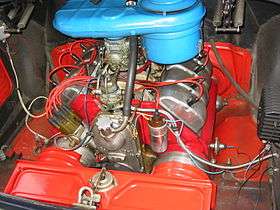
The 1934–1938 Tatra 77 rear-engined sedan was initially powered by 3.0 L (183 cu in) petrol V8, which was air-cooled and used an overhead camshaft that operated the valves using a 'walking beam' rocker arrangement. This model line continued until 1999, when the Tatra 700 ended production.
Tatra also produced diesel V8 truck engines from the 1939 Tatra 81 to the present day Tatra 815.
France
French manufacturers were pioneering in their use of V8 engines in the early 1900s with the 1904 Antoinette aircraft engine (the first known V8 engine) and the 1910 De Dion-Bouton. However, there were few French automotive V8 engines in the following decades, with manufacturers such as Delage, Delahaye, Talbot-Lago, Bugatti, and Hotchkiss instead using six-cylinder or straight-eight engines.
From 1935 to 1954, Matford (Ford's French subsidiary, later renamed to 'Ford SAF') produced cars with V8 engines, closely based on contemporary American Ford models. Simca purchased the Ford SAF in 1954 and continued to produce various models powered by the Ford Flathead V8 until 1969.[22]
After WW2, France imposed very steep tax horsepower charges - the owners of cars with engines above 2 litres were financially penalized, so France had a very small domestic market for larger engined cars, such as the V8.[23] Despite this, Facel Vega produced luxury and sports cars powered by Chrysler V8 engines from 1954 to 1964.[23]
Germany
One of the first German V8 engines was the 1928–1945 Argus As 10 aircraft engine. This engine was air-cooled, used an 'inverted V' design and was used in several training, reconnaissance and communications airplanes.
From 1933 to 1940, the Horch 830 luxury cars were powered by V8 engines (sold alongside Horch's larger straight-eight engines). Shortly after, the 1934–1937 Stoewer Greif V8 was powered by a 2.5 L (153 cu in) V8 engine.
BMW's first V8 engine was the 1954–1965 BMW OHV V8 engine, a petrol engine with overhead valves and all-aluminium construction. The company resumed production of V8 engines in 1992 with the BMW M60 aluminium double overhead camshaft engine, and V8 engines have remained in production until the present day. The first turbocharged V8 engine from BMW was the 2008-present BMW N63 engine.
Mercedes-Benz began production of the Mercedes-Benz M100 petrol V8 engine in 1963 and has continued production of V8 engines to the present day. The M100 had a single overhead camshaft, a cast-iron block and an aluminium head. Supercharging was first used on the Mercedes-Benz M113 engine in 2002 and turbocharging was first used on the Mercedes-Benz M278 engine in 2010.
Porsche's first road car to use a V8 engine was the 1978 Porsche 928 coupe.
Audi's first road car to use a V8 engine was the 1988 Audi V8 luxury sedan.
Italy
- Alfa Romeo
The first V8-engined Alfa Romeo road car was the 1967–1969 Alfa Romeo 33 Stradale mid-engined sports car, of which 18 cars were produced. This was followed by the 1970–1977 Alfa Romeo Montreal front-engined sports car. The engines for both cars are based on the 90-degree V8 engine from the Alfa Romeo Tipo 33 racing car, and have double overhead camshafts and a dry sump. The 33 Stradale engine has a displacement of 2.00 L (122 cu in) and a flat-plane crankshaft, while the Montreal uses an engine enlarged to 2.6 L (160 cu in) and uses a cross-plane crankshaft.[24]
The 2007–2010 Alfa Romeo 8C Competizione / Spider sports cars are powered by a 4.7 L (290 cu in) version of the Ferrari F136 engine with a cross-plane crankshaft.
- Ferrari
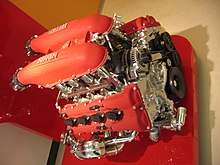
Ferrari's first contact with V8 engines was the 1955 Lancia-Ferrari D50, a Formula One racing car that the company acquired as part of its purchase of Lancia's Formula One racing department. The first Ferrari-developed V8 engines were used in the 1962 Ferrari 248 SP and Ferrari 268 SP sports prototype racing cars, designed by Carlo Chiti. This engine had a single overhead camshaft and was rear-mounted in the cars.
The company's first V8 road car was the 1973–1974 Dino 308 GT4 mid-engined sports car. The engine is a 90-degree all-aluminium V8 with double overhead camshafts.[25] In 1975, the 2.0 L (122 cu in) engine in the Ferrari 208 GT4 became the smallest production V8 engine ever produced. The model lineage of mid-engined V8 road cars continues to the 2019-present Ferrari F8 Tributo.
Five-valve-per-cylinder versions were used 1994–2005 in the Ferrari F355 and Ferrari 360. Turbocharging was introduced on the 1984–1987 Ferrari 288 GTO flagship car and the range of entry-level mid-engined sports cars switched to turbocharging with the 2015 Ferrari 488.
The Formula One team resumed usage of V8 engines for the 2006–2013 seasons, beginning with the Ferrari 248 F1.
- Maserati
The first Maserati V8 road car was the 1959–1965 Maserati 5000 GT luxury coupe, of which only 34 cars were produced. The 5000 GT used a 4.9 L (299 cu in) overhead camshaft engine derived from the Maserati 450S racing car. Developments of this engine were used in the 1963–1969 Maserati Quattroporte I luxury sedan, the 1967–1973 Maserati Ghibli, the 1971–1978 Maserati Bora 2-seat coupe, and several other models.
The 1990–1996 Maserati Shamal 2+2 coupe introduced a 3.2 L (195 cu in) turbocharged V8 engine based on the existing Maserati Biturbo V6. This engine was later replaced by the naturally aspirated 4.2 L (256 cu in) Ferrari F136 V8 engine, beginning with the 2001 Maserati Coupé / Spyder.
- Other Italian manufacturers
During the 1920s and 1930s, Lancia produced a line of range-topping luxury cars powered by V8 engines: the 1922–1925 Lancia Trikappa, the 1928–1935 Lancia Dilambda, and the 1931–1939 Lancia Astura. The engines ranged in displacement from 2.6–4.6 L (159–281 cu in) and used unusually narrow V-angles of 14 to 24 degrees with a single overhead camshaft. In the 1980's, an engine derived from Ferrari's V8 engine was transverse mounted in the Lancia Thema 8.32.
The only Fiat car to use a V8 engine was the Fiat 8V, of which approximately 100 were produced 1952–1954. The 2.0 L (122 cu in) pushrod engine used an all-aluminium construction and an unusual V-angle of 70 degrees.[26] Fiat also began production of V8 diesel truck engines for the 1975 Des-8280,[27] initially in naturally aspirated form before switching to turbocharging in the mid-1980s.
Lamborghini's V8 powered models are the 1972–1979 Lamborghini Urraco 2+2 coupe, 1976–1979 Lamborghini Silhouette 2-seat convertible, and 1981–1988 Lamborghini Jalpa 2-seat convertible. The 2018-present Lamborghini Urus SUV uses a Volkswagen Group turbocharged V8 engine.
Japan
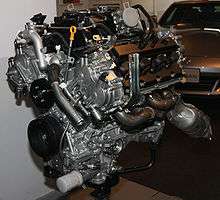
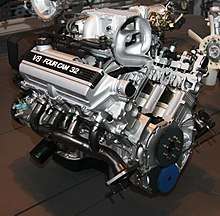
Japanese manufacturers have not been large producers of V8 engines for passenger cars, due to Japanese government road tax regulations that impose higher charges for engines that exceed 2.0 L (122 cu in). However several passenger cars have been produced with V8 engines to meet the needs of consumers, as well as for use in motor racing.
- Honda
Honda has never produced V8 engines for passenger vehicles. In the late 1990s, the company resisted considerable pressure from its American dealers for a V8 engine with American Honda reportedly sending one dealer a shipment of "V8" vegetable juice to silence them.[28] The only Honda car sold with a V8 engine was the 1993–1998 Honda Crossroad SUV, which was a rebadged Land Rover Discovery Series I fitted with the Rover V8 engine.
In motor racing, the Honda Indy V8 was produced for the 2003–2011 IndyCar racing series and was the control engine for the 2006–2011 seasons. The engine was a 3.0–3.5 L (183–214 cu in) all-aluminium V8 with double overhead camshafts and a redline of 10,300 rpm redline. The 2006–2008 Honda Racing F1 Team used V8 engines, as mandated by Formula One regulations.
- Mitsubishi
From 1999 to 2000, Mitsubishi briefly sold the Mitsubishi 8A8 engine, which was a 4.5 L (275 cu in) all-aluminium V8 engine with double overhead camshafts and direct injection. The engine was fitted to the Mitsubishi Proudia luxury sedan and Mitsubishi Dignity limousine, however financial pressures forced the company to discontinue sales of both these vehicles after only fifteen months.[29]
- Nissan
The 1965–1989 Nissan Y engine is Nissan's first V8 engine, which uses a pushrod design and had a displacement of 4.0 L (244 cu in). Its main use was in the Nissan President limousine. The Y engine was replaced by the 1989–2001 Nissan VH engine, which is an all-aluminium construction with double overhead camshafts and displacements of 4.1–4.5 L (250–275 cu in). This was replaced by the Nissan VK engine in 2002, which remains in production to the present day. The VK engine is an all-aluminium construction with double overhead camshafts and displacements of 4.5–5.6 L (275–342 cu in).
- Toyota
The first mass-produced Japanese V8 engine was the Toyota V engine, which was introduced in the 1964 Toyota Crown Eight luxury car. The Toyota V engine was an all-aluminium construction, used a pushrod valvetrain and was produced until 1997. The Toyota UZ engine has double overhead camshafts and was produced 1989–2013, while the Toyota UR engine added direct injection and has been in production since 2006.
From 2006 to 2009, the Toyota Racing Formula One team cars were powered by 2.4 L (146 cu in) naturally aspirated engines, as mandated by the Formula One rules. These Toyota engines were also used by the Williams, Midland, and Jordan teams.
Korea
Hyundai's first passenger car V8 engine was the 1999–2009 Hyundai Omega engine, which was based on the Mitsubishi 8A8 engine (see above). The Omega engine was replaced by the Hyundai Tau engine, which is an all-aluminium construction with double overhead camshafts and has been produced from 2008-present.
Sweden
Koenigsegg initially used twin-supercharged versions of the Ford Modular V8 engine in its 2002–2004 Koenigsegg CC8S and 2004–2006 Koenigsegg CCR. The company switched to its own twin-supercharged engine for the 2006–2010 Koenigsegg CCX. A twin-turbocharged V8 engine was introduced in the 2011 Koenigsegg Agera and has been used on all models since.[30][31]
Soviet Union
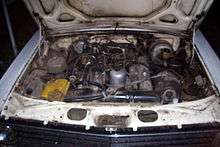
The 1958–1967 ZIL-111 limousine was among the first Soviet cars to be powered by a V8 engine. The engine was an all-aluminium construction with a pushrod valvetrain. Production of ZIL limousines powered by V8 engines continued until the ZIL-41047 was discontinued in 2002.
The 1959–1988 GAZ Chaika was powered by a 5.5 L (336 cu in) V8 engine with an all-aluminium construction and a pushrod valvetrain. This engine was also used in several limited edition models for the KGB.
United Kingdom
- Aston Martin
The 1969–1972 Aston Martin DBS V8 coupe/convertible was Aston Martin's first V8 model. This engine was an all-aluminium construction with double overhead camshafts, and was used in several models up until 2000, when the Virage model was discontinued.
Production of V8-engined Aston Martin cars resumed in 2005 with a new generation of the Vantage, powered by the Jaguar AJ-V8 naturally aspirated V8 engine.[32][33][34][35] Since 2016, Aston Martin has switched to the Mercedes-Benz M177 turbocharged V8 engine, beginning with the DB11 model.[36][37]
- McLaren
Every McLaren road car since the brand's 2010 relaunch has been powered by the McLaren M838T twin-turbocharged V8 engine, which was introduced in the McLaren 12C (then called the 'MP4-12C') coupe. This engine is an all-aluminium construction with double overhead camshafts and a flat-plane crankshaft.
- Rolls-Royce
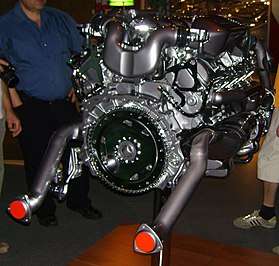
The first V8 engine to be produced in the United Kingdom was fitted to the 1905 Rolls-Royce V-8, of which 3 cars were produced. This engine used a side valve design, a V-angle of 90 degrees and had a displacement of 3.5 L (214 cu in).
Mass-production of V8 engines began in 1959 with the release of the Rolls-Royce–Bentley L-series V8 engine in the Rolls-Royce Silver Cloud II, the Rolls-Royce Phantom IV, and the Bentley S2. This engine is an all-aluminium construction with a pushrod valvetrain and a V-angle of 90 degrees. It has been produced in displacements of 5.2–7.4 L (317–452 cu in), with a twin-turbocharged version introduced in 1985. The L-series V8 engine remains in production in the Bentley Mulsanne luxury sedan.[38][39]
- Rover
Rover began production of automotive V8 engines in 1967 with the Rover V8 engine. This engine used the design and tooling of the Buick V8 engine purchased from General Motors.[40] The Rover V8 is an all-aluminium construction with a pushrod valvetrain, displacements of 4–5 L (215–305 cu in) and a V-angle of 90 degrees. It was used in various automobiles by Rover, Land Rover, and MG.
Production continued until 2006, when it was largely replaced by the Jaguar AJ-V8 engine.
- Other U.K. manufacturers
The Daimler V8 engine was introduced in the 1959 Daimler SP250 sports car and was produced until 1969. This engine has an iron block, an alloy cylinder head, a pushrod drivetrain and was produced in displacements of 2.5–4.5 L (153–275 cu in).
The Jaguar AJ-V8 engine— Jaguar's first V8 engine for road cars— has been in production since 1996. This engine is an all-aluminium construction with double overhead camshafts. It has been produced in both naturally aspirated and supercharged configurations.
Land Rover and Range Rover produced vehicles fitted with the Rover V8 naturally aspirated petrol engine 1970–2004, the Ford TDV8 turbocharged diesel engine 2007–2012, the BMW M62 naturally aspirated petrol engine 2002–2006, the Jaguar AJ-V8 from petrol engine (in both naturally aspirated and supercharged configurations) from 2006-present and the Ford 4.4 Turbo Diesel engine from 2010-present.
The 1970–1977 Triumph V8 was used solely for the Triumph Stag coupe. This engine had a cast iron block, an aluminium cylinder head, single overhead camshafts and a displacement of 3.0 L (183 cu in).
The 1996–2003 TVR Speed Eight engine was used in the Chimera road cars and the Tuscan Challenge racing cars. This engine had an all-aluminium construction, single overhead camshafts, a flat-plane crankshaft and an unusual V-angle of 75 degrees.
United States
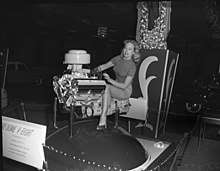
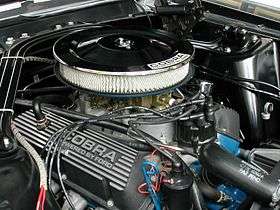
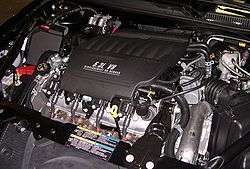
The first automotive V8 engine to reach production was the 1914–1935 Cadillac L-Head engine introduced in the Type 51.[41] The L-head had an alloy crankcase, a single iron casting for each cylinder block and head, side valves, a flat-plane crankshaft and a displacement of 5.1 L (314 cu in).[42] An electric starter motor was used, eliminating the large engines being difficult to start with hand-cranking. The Cadillac engine was followed by a V8 model from Peerless (using an engine manufactured by an amusement park manufacturer) in 1915.[43][44]
The first American V8 production engine with overhead valves (a 'pushrod' engine) was used by the 1917 Chevrolet Series D. This engine used a counterweighted crankshaft, a detachable crossflow cylinder head, and had a displacement of 4.7 L (288 cu in).[45] Production of the Series D models ceased in 1918, Chevrolet did not produce another V8 engine until 1955.
The 1924 Cadillac Type V-63 was powered by the first American V8 to use a cross-plane crankshaft, which reduced vibrations.[46] A year later, Peerless also introduced a cross-plane crankshaft V8. Other manufacturers producing V8 engines by the mid-1920s included Lincoln, Ferro, Northway (supplier to Cadillac), Cole (Indianapolis and Mississippi), Perkins (Detroit), Murray, Vernon, and Yale.[47]
A significant development in providing V8 engines in more affordable cars was the 1932–1954 Ford Flathead V8. The Flathead V8 reduced production costs by using a monobloc (or "en block") construction, where each cylinder bank is made from a single piece of cast metal. The engine was fitted to the low cost Ford Model 18 car, offering superior performance to its competitors.[48]
Demand for larger cars increased in the years following World War II and the wider bodies were well suited to the fitment of V8 engines. This led to many manufacturers introducing overhead valve V8 engines, such as the 1949–1964 Oldsmobile Rocket engine, the 1949–1962 Cadillac 331 engine, the 1951–1958 Chrysler Firepower engine, the Studebaker's 1952 V8 engine, the 1953–1966 Buick Nailhead engine, the 1954–2002 Chevrolet small-block engine, the 1954–1963 Lincoln Y-block V8 engine, the 1955–1981 Pontiac V8 engine, and the 1956–1967 AMC Rambler engine.[49][50]
Engine displacements grew in conjunction with the expanding size of full-size cars through the 1950s to mid-1970s. This led to 'big block' engines such as:
- 7.0 L (428 cu in) Ford FE engine released in 1956
- 6.0 L (368 cu in) Lincoln Y-block engine released in 1956
- 6.9 L (421 cu in) Pontiac Super Duty engine released in 1961
- 7.0 L (426 cu in) Chrysler Hemi engine released in 1965
- 7.4 L (454 cu in) Chevrolet big-block engine released in 1970.
The classification of 'big-block' or 'small-block' refers to the engine's external dimensions and is not necessarily indicative of the actual engine displacement. Engines with displacements between 6.0–6.6 L (366–403 cu in) have been classified as both small-block and big-block, depending on the particular manufacturer's range of engines.[51] Big-block engines reached their zenith with the 8.2 L (500 cu in) Cadillac 500 engine used in the 1970 Cadillac Eldorado coupe. During the 1970s, due to the oil crises and the gradual tightening of emission-standards, big-block V8s were affected and as a result their use in passenger cars decreased as manufacturers began to phase them out for more efficient designs.
Prior to the late 1970s, sharing of engines across General Motors' divisions was not commonplace. This enabled each division to have its own unique engine character, but made for much duplication of effort. The company has since implemented sharing of engines across divisions, however some divisions (such as Cadillac) still maintain some engines specific to their division. Ford and Chrysler had fewer divisions, and favoured brand-specific shared designs.
In 2011 GM built its 100-millionth unit of the Chevrolet small-block engine, making that engine family the most produced V8 engine in the world.[52]
American manufacturers continue to produce large displacement V8 engines, despite the strategy of downsizing engines (often in conjunction with turbocharging) being adopted by many European and Asian manufacturers.[53][54][55][56] These engines continued to use pushrod (overhead valve) valvetrains long after most overseas engines had switched to dual overhead camshaft designs. Examples include the 6.4 L (392 cu in) Chrysler Apache engine produced from 2011-present, the 7.3 L (445 cu in) Ford Godzilla engine produced from 2020-present,[57][58][59][60] and the 6.6 L (401 cu in) Chevrolet L8T engine produced from 2020-present.[61][62][63][64][65]
Cadillac's Cadillac LTA engine codenamed "Blackwing" developed, hand built, and exclusively used by Cadillac on its mid-range vehicles sporty sedans and coupes[66] employs a turbocharged 4.2 L (256 cu in) configuration with double overhead camshaft valve train, marking the first time in the brand's 100-plus-year history that a twin-turbo charged V8 unit is used.[67]
Motorsport
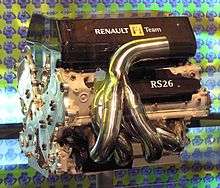
V8 engines have been used in many forms of motorsport, from Formula One, IndyCar and NASCAR circuit racing, to Top Fuel drag racing.
- Formula One
Among the first V8 Formula One cars to compete were the 1952 AFM entry and the 1954 Lancia D50, with a development of the latter powering Juan Manuel Fangio's 1956 car to victory in the driver's championship. The 1.5 L Formula One era of 1961–1965 included V8 engines from Ferrari, Coventry Climax, British Racing Motors (BRM), and Automobili Turismo e Sport (ATS). The driver's championships for the 1962, 1963, 1964, and 1965 seasons were won by drivers of V8-powered cars. Also, from 1962 to 1965, the top three manufacturers in each season's Constructor's Championship all predominantly used V8 engines in their cars. In 1966, the engine capacity limits were increased to 3.0 litres (or 1.5 litres with a supercharger), and 1966–1967 Constructor's Championships were won by cars powered by the Brabham-Repco V8 engine.
From 1968 to 1981, the Cosworth DFV V8 engine dominated Formula One racing. During this time, the Manufacturers' Championship was won by Cosworth DFV powered cars every season except 1975, 1976, 1977, and 1979, which were won by 12-cylinder Ferraris. After a very long period of dominance, the Cosworth DFV was eventually outpaced by turbocharged straight-four and V6 engines.
The next period of significant V8 usage in Formula One was from 2006 to 2013, when the rules mandated use of 2.4 L (146 cu in) naturally aspirated V8 engines (in order to reduce the power outputs being achieved by the previous 3.0 litre V10 engines).[68] These were replaced by 1.6 litre turbocharged V6 engines for the 2014-present seasons.
- NASCAR
American premier stock car racing NASCAR series has been dominated by V8 engines since the its inaugural 1949 season.
- Drag racing
In the American Top Fuel class of drag racing, V8 engines displacing 500 cu in (8 L) today produce outputs of over 7,000 kW (10,000 hp).[69] and 10,000 N⋅m (7,400 lb⋅ft).[70][71][72] The engines used in Top Fuel and Funny car drag racing are typically based on the aluminum-conversion Chrysler 426 Hemi engine and run on highly explosive nitromethane fuel.[73]
- Land speed record racing
The world's fastest non-jet-powered (i.e. piston-engine powered) wheeled land vehicle, the Speed Demon, which achieved a speed of 462.345 mph in 2017, is powered by an V8 engine based on the Chevrolet small-block engine design.[74][75][76][77][78]
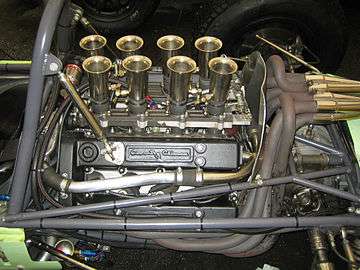 1962 Coventry Climax FWMV Formula One engine
1962 Coventry Climax FWMV Formula One engine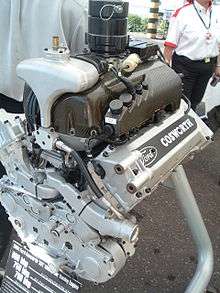 2004 Cosworth XF Champ Car engine
2004 Cosworth XF Champ Car engine
Usage in airplanes
.jpg)
Several early aircraft engines used a V8 configuration, such as the French 1904 Antoinette engine and 1906 Buchet engines. During World War One, V8 aircraft engines included the French Renault 8G, the Spanish Hispano-Suiza 8, the British Sunbeam Arab, and the American Curtiss OX-5.
After this time, flat-eight engines became more commonplace than V8 engines due to their lighter crankshafts and better suitability to air cooling. One of the few remaining V8 airplane engines by World War Two was the German Argus As 10 inverted V8, which was air-cooled and used in several trainer as well as small utility aircraft.[79]
Usage in marine vessels
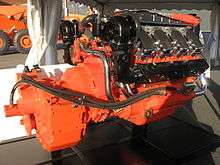
The V8 configuration is not commonly used in marine vessels, however several marine diesel V8 engines have been produced by companies such as Brons, Scania, and Yanmar.
Usage in motorcycles
Motorcycles have rarely used V8 engines, with the few in existence being built for motor racing.
In 1907, Glen Curtiss set an unofficial world record of 136.36 mph (219.45 km/h) on a home-made 4.0 L (244 cu in) motorcycle.[80] The Moto Guzzi V8 was a 499 cc (30.5 cu in) motorcycle used for Grand Prix racing from 1955 to 1957.[81] The 1994 Morbidelli V8 was a 848 cc (51.7 cu in) concept motorcycle which did not reach production.
References
- Nunney, Malcolm James (2006). Light and Heavy Vehicle Technology (Fourth ed.). Butterworth-Heinemann. pp. 13–14. ISBN 0-7506-8037-7.
- McIntosh, Jil (10 June 2005). "First Drive: 2006 Volvo XC90 V8". Autos Canada. Retrieved 25 January 2013.
- Robson, Graham (1977). The Rover Story. Cambridge: Patrick Stephens. p. 51. ISBN 0-85059-279-8.
- Daniels, Driving Force, pp. 70-71, 92
- Borgeson, Griffith (2000). The Last Great Miller: The Four Wheel Drive Indy Car. SAE International. ISBN 0-7680-0500-0.
- "The Physics of: Engine Cylinder-Bank Angles". www.caranddriver.com. 14 January 2011. Retrieved 3 January 2020.
- Ludvigsen, Karl (2001). Classic Racing Engines. Haynes Publishing. ISBN 1-85960-649-0.
- Torchinsky, Jason (17 November 2014). "What Is A Flat-Plane Crank And Why Is It So Loud? An Explainer". Jalopnik. Retrieved 11 July 2015.
- Ludvigsen, Classic Racing Engines, pp. 174–177
- "Who Invented the V8 Engine?". www.itstillruns.com. Retrieved 1 January 2020.
- "The V8 Engine". www.uniquecarsandparts.com.au. Retrieved 1 January 2020.
- Rumerman, Judy. "U.S. Centennial of Flight Commission - Early Aircraft Engines". centennialofflight.net. Retrieved 4 September 2014.
- Evans, Michael (2004). In the Beginning-the Manchester Origins of Rolls-Royce. Derby, UK: Rolls-Royce Heritage Trust. ISBN 1-872922-27-9.
- "The Hewitt Automobiles & The Hewitt Motor Company". American Automobiles. Farber and Associates.
- "Lost Marques: DeDion Bouton". www.uniquecarsandparts.com. Retrieved 1 January 2020.
- Daniels, Jeff (2002). Driving Force: The Evolution of the Car Engine. Haynes Publishing. pp. 32–33. ISBN 1-85960-877-9.
- "Engine's history". www.topspeed.com. Retrieved 3 January 2020.
- "Volvo XC90 gets the state-of-the-art V8 powertrain for 2005". The Auto Channel. 2004. Retrieved 27 December 2008.
- "Shanghai Car Museum: 1959 Hongqi CA72". www.carnewschina.com. 5 December 2012. Retrieved 4 January 2020.
- "Up Close With China's Beautiful, Strange and Almost Never Seen Presidential Cars". www.jalopnik.com. Retrieved 4 January 2020.
- "A Pair of Exquisite Hong Qi Limousines Will Be the First Chinese Cars Ever To Be Featured at Pebble Beach". www.jalopnik.com. Retrieved 4 January 2020.
- "Simca Vedette And Simca Ariane". Simcatalbotclub.org. Retrieved 15 April 2015.
- "The Facel Vega: Chrysler-powered luxury from France". Allpar.com. Retrieved 15 April 2015.
- Giuliani, Luigi (1992). Alfa Romeo Montreal. Vimodrone, Italy: Giorgio Nada Editore. ISBN 88-7911-072-1.
- "Ferrari Dino 208 GT4 (1975)". www.ferrari.com. Retrieved 5 January 2020.
- "Motore FIAT tipo 104 8V". www.museomotori.unipa.it. Retrieved 5 January 2020.
- "Iveco Fiat v8 type 8280 22133". www.cabmasters.com. Retrieved 5 January 2020.
- News, Automotive (17 October 2008). "Green-car era poses test for Honda | The Car Tech blog - CNET Reviews". Reviews.cnet.com. Archived from the original on 20 October 2008. Retrieved 22 November 2009.
- "MMC Announces New Management Organization, Details Major Progress". www.mitsubishi-motors.com. Archived from the original on 9 May 2004.
- "CCX". Koenigsegg.com. Retrieved 3 March 2017.
- "Koenigsegg CC8S 2002-2004". Autocar.co.uk. 23 September 2003. Retrieved 3 March 2017.
- Burt, Matt (11 January 2016). "Aston Martin confirms new 5.2-litre V12 twin-turbocharged engine". Autocar. Retrieved 12 March 2016.
- "Aston Martin Engine Plant". Aston Martin. Retrieved 12 March 2016.
- Vijayenthiran, Viknesh (25 June 2013). "Has Aston Martin Just Extended Its Engine Deal With Ford?". Motor Authority. Retrieved 12 March 2016.
- "Aston Martin signs new Ford engine deal". Autocar. 24 June 2013. Retrieved 12 March 2016.
- Ulrich, Lawrence. "The New Aston Martin Vantage Borrows Some V-8 Sugar from Mercedes-AMG's GT...So Which Tastes Sweeter?". The Drive. Retrieved 11 July 2018.
- "DB11 becomes the first Aston Martin with a Mercedes-AMG heart". newatlas.com. Retrieved 11 July 2018.
- "Mulsanne: Detailed Specification". Bentleymotors.com. Retrieved 15 April 2015.
- Tisshaw, Mark (16 September 2014). "Performance-focused Bentley Mulsanne Speed unveiled". Autocar.co.uk. Retrieved 15 April 2015.
- Wirth, Thomas (1 September 2004). "Rover V8-Motor: Born in the USA". Auto-motor-und-sport.de. Retrieved 3 March 2017.
- Sessler, Peter (2010). Ultimate American V-8 Engine Data Book: 2nd Edition. Motorbooks. ISBN 978-0-7603-3681-6.
- "Century Club: The 100-Year History of Cadillac V-8s". www.caranddriver.com. 25 July 2014. Retrieved 11 January 2020.
- "Peerless". www.uniquecarsandparts.com. Retrieved 11 January 2020.
- "The Three Ps of Motordom: Pierce-Arrow, Peerless and... Panteras?". www.thetruthaboutcars.com. 17 November 2013. Retrieved 11 January 2020.
- "1917 Chevrolet Series D V-8". HowStuffWorks. Retrieved 14 July 2016.
- "V8 Engines - Crossplane". www.backfire.ca. Retrieved 19 January 2020.
- G.N. Georgano, G.N. (2002). Cars: Early and Vintage, 1886–1930. Mason Crest Publishers. ISBN 978-1-59084-491-5.
- Banham, Russ (2002). Ford Century: Ford Motor Company and the Innovations that Shaped the World. pp. 32–55.
- Donovan, Leo (January 1956). "Detroit Listening Post". Popular Mechanics. 105 (1): 122. Retrieved 25 January 2013.
- Gunnell, John (2006). Standard Catalog of American Muscle Cars 1960–1972. Krause Publications. p. 8. ISBN 978-0-89689-433-4. Retrieved 25 January 2013.
- Lirones, Brett (24 September 2018). "6 of America's smallest big-blocks and biggest small-blocks". Hagerty. US. Retrieved 12 April 2019.
- Lingeman, Jake (28 November 2011). "GM builds 100-millionth small-block engine". Autoweek. Retrieved 15 April 2015.
- Bubear, Ryan (17 October 2016). "Downsizing is dead! Bigger engines to be revived?". CAR magazine. South Africa. Retrieved 20 April 2019.
- Sorokanich, Bob (14 October 2016). "Europe's Emissions Crisis Is Causing a Return to Bigger Engines". Road and Track. US. Retrieved 20 April 2019.
- Lesage, Jon (14 October 2016). "Tougher European Emissions Tests Forcing Automakers To Reverse Course on Downsized Engines". Hybrid Cars. Canada. Retrieved 20 April 2019.
- DeMuro, Doug (6 February 2015). "Why Do Americans Insist On Having Such Large Engines?". Jalopnik. US. Retrieved 20 April 2019.
- "Ford's 7.3-Liter 'Godzilla' Gas Engine Delivers 430 Horsepower & Packs Monster Potential". www.hotrod.com. Retrieved 13 January 2020.
- "New Ford 7.3-Liter "Godzilla" Gasoline V-8 Coming for Super Duty Lineup". www.yahoo.com. Retrieved 13 January 2020.
- Ramsey, Jonathon (11 February 2019). "Ford's new 'Godzilla' 7.3-liter V8 will fit in Mustang, F-150 Raptor". Autoblog. US. Retrieved 20 April 2019.
- Duty, Ford Super. "Ford Says Its New 7.3-Liter V8 Can Fit In The F-150, Mustang". Motor1.com.
- "The New GM L8T Engine Is A 401ci Gen-V That Hot-Rodders Will Love". www.enginelabs.com. 2 April 2019. Retrieved 13 January 2020.
- "6.6L V8 L8T GM Engine Specs Released". www.gmauthority.com. Retrieved 13 January 2020.
- Trucks, Hard Working. "Video: Chevy engineer talks about new 6.6-liter V8". www.hardworkingtrucks.com.
- Peters, Sam (13 February 2019). "Chevrolet 2020 Silverado HD to get new 6.6-liter V8". Engine Technology International. UK. Retrieved 16 June 2019.
- Gauthier, Michael (5 February 2019). "2020 Chevrolet Silverado HD Debuts With New 6.6-liter V8 And 35,500 Pound Towing Capacity". Carscoops. Retrieved 16 June 2019.
- Joseph, Noah (18 March 2019). "Cadillac Doesn't Want To Share Its Blackwing Engine". CarBuzz. US. Retrieved 13 February 2020.
- "Cadillac Introduces First-Ever Twin-Turbo V-8 Engine" (Press release). US: Cadillac. 21 March 208. Retrieved 13 February 2020.
- "FOTA meeting" (Press release). FIA. 10 December 2008. Archived from the original on 17 December 2008.
- "8,000 Horsepower Top Fuel Dragsters @ 300 MPH". Zero To 60 Times. Retrieved 3 March 2017.
- "Forget 8,000 horsepower ... Top Fuel is now over 10,000 Horsepower! [National Dragster]". Nfvzone.com. 2 August 2014. Retrieved 3 March 2017.
- Hartman, Jeff (2011). Supercharging Performance Handbook. Motorbooks. p. 206. ISBN 9780760339381. Retrieved 30 September 2014.
- "Forget 8,000 horsepower ... Top Fuel is now over 10,000 horsepower!". SIP Trunking. 2 August 2014. Retrieved 14 July 2016.
- "Top Fuel Dragster". Universal Auto. Retrieved 14 July 2016.
- Sam (21 August 2013). "Speed Demon smashes land speed record". Racecar Engineering. Retrieved 3 March 2017.
- Rettie, John (4 October 2012). "New World Speed Record for a Piston-Engined Car – 439 mph". Roadandtrack.com. Retrieved 3 March 2017.
- "Speed Demon: The world's fastest piston engine, wheel driven car". Turbosmartusa.com. 15 December 2015. Retrieved 3 March 2017.
- "Fastest Piston Engine Car: 'Speed Demon' sets world record (VIDEO)". Worldrecordacademy.com. Retrieved 3 March 2017.
- "News Archives". Hot Rod Network. Retrieved 3 March 2017.
- "World's Most Powerful Aviation V-8". US: TRACE Engines. Retrieved 14 July 2016.
- de Cet, Mirco (2002). The illustrated directory of motorcycles. MBI Publishing. p. 116. ISBN 978-0-7603-1417-3.
- "Greatest Motorbikes Ever". www.discoverychannel.co.uk. Archived from the original on 3 October 2009.
| Wikimedia Commons has media related to V8 engines. |